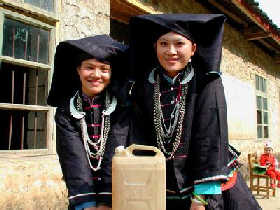Source: China Daily
09-22-2006 10:51

The Zhuang is China's largest ethnic minority, with a population of 15.5 million (by 1990), approaching that of Australia. Most of the Zhuangs live in southwestern China's Guangxi Zhuang Autonomous Region, which is nearly the size of New Zealand. The rest settle in Yunnan, Guangdong, Guizhou and Hunan provinces.
The Zhuang ethnic minority has its own language, which belongs to the Zhuang-Dai branch of Zhuang-Dong Austronesian, part of the Chinese-Tibetan Phylum. Ancient Zhuang characters appeared in the Southern Song Dynasty (1127-1279), but never got popularized. In 1955 the central government helped them create a writing system based on the Latin alphabet. Still the Chinese language is commonly used among the Zhuangs.
Tens of thousand years ago, ancestors of the Zhuang settled down in southern China. During the Spring and Autumn Period (770-221BC), they were one branch of the Baiyue people. The Zhuang areas first came under the administration of China's central authority 2,000 years ago. In 221 BC, the first emperor of the Qin Dynasty (221-206BC), China's first feudal emperor to unify the country, conquered the area and established three prefectures there.
"Zhuang" was one of the names the ancestors of this ethnic minority gave to themselves. The term was first recorded some 1,000 years ago, in the Song Dynasty. The Zhuangs used to call themselves by at least a dozen other names, too. In 1958, the Guangxi Zhuang Autonomous Region was set up and in 1964 the group was proved by the State as the Zhuang ethnic minority.
The Zhuangs are mainly engaged in agriculture, with paddy and corn as their main crops. San Qi and Hui Oil are the most famous special local products. Zhuang brocade, famous both at home and abroad, is a splendid handicraft which originated in the Tang Dynasty (618-907). Woven in beautiful designs with natural cotton warp and dyed velour weft, the brocade is excellent for making quilt covers, table-clothes, braces, aprons and handbags.
Legends, fairy tales, stories and ballads frame the folk literature of the Zhuangs who have also been reputed for their singing. Sweet songs can be heard wherever you go in the Zhuang area. Extemporaneous melodies and lyrics and clever use of metaphors, riddles and cross-examinations add charm to their songs.
The Zhuangs are polytheists, worshipping among other things like giant rocks, old trees, high mountains, land, dragons, snakes, birds and ancestors. Taoism and Buddhism have also had a deep influence on the Zhuangs since the Tang Dynasty (618-907). Foreign missionaries of Christianity and Catholicism came to the area in the 19th and early 20th centuries, but their influence was limited to cities and towns.
While sharing many festivals with the Hans, such as the Spring Festival, the Mid-autumn Festival, the Dragon Boat Festival, etc., the Zhuangs have their own traditional festivals: the Devil Festival, the Cattle Soul Festival, the Feasting Festival, and the Singing Festival (on the third of the third lunar month), among which the Singing Festival is the most famous.
Editor:Lu Yuying
